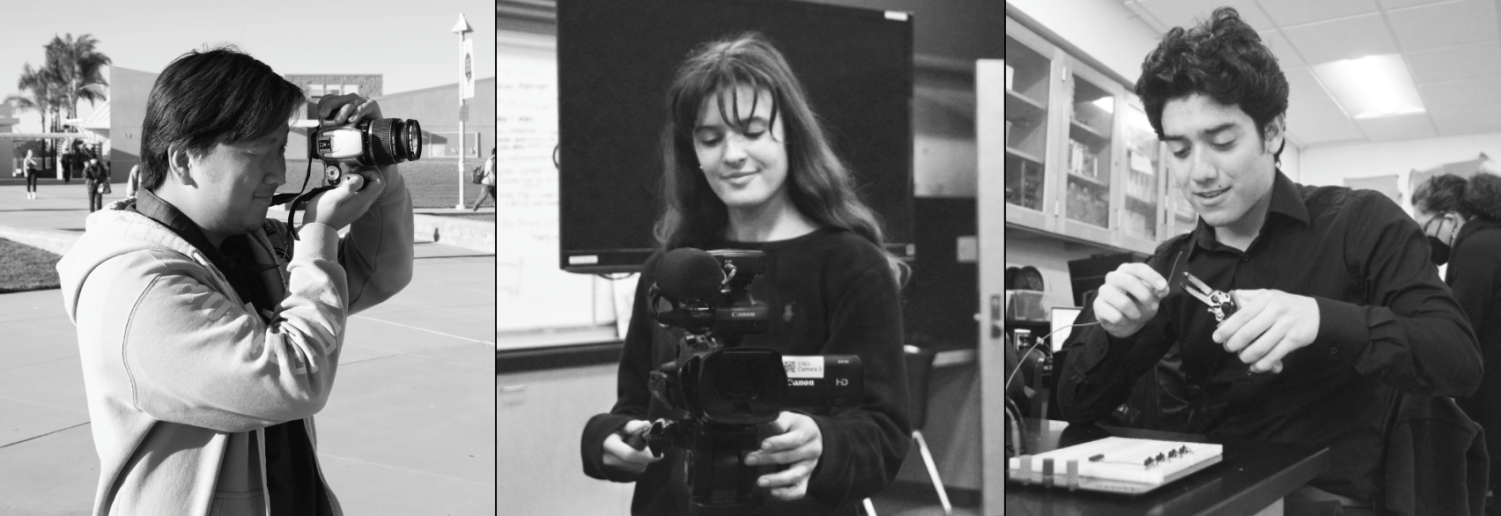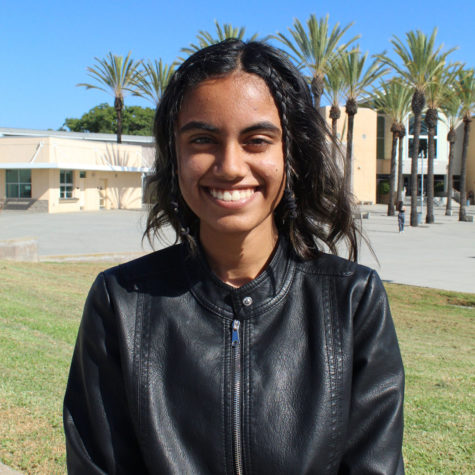Students pursue career technical education
February 10, 2023

Westview is home to eight Career Technical Education (CTE) Pathways, specializing in areas ranging from biotechnology to performing arts. There are three additional pathways offered to Westview students: emergency response, residential & commercial construction, and systems diagnostics, services, & repairs. Completing a CTE Pathway allows students to receive a certificate, diploma seal, and a notation on their transcript.
Engineering Design Pathway
As a child, Agosto Villalva (12) dreamt of becoming an astronaut. His fascination with engineering and technology continued as he explored the field both in and out of the classroom, from Westview Theatre Company’s tech crew to courses such as Honors Principles of Engineering (POE) and Digital Electronics under the Engineering Design CTE Pathway.
“When I took Principles of Engineering, I didn’t know about the CTE Pathway,” Villalva said. “I found out when I took POE, and because POE was such a good experience, it convinced me to take [Digital Electronics] too.”
Many CTE courses, including POE, also give students college credit. For Villalva, the class’ unique content distinguished it from others.
“I’m learning about things I’ve never heard before, like oscilloscopes and breadboards and I’m wondering about devices that I would use [as a future engineer],” Villalva said. “[Science teacher Dawn] Hester always refers to stuff that we would use in an actual career as an engineer, so it’s interesting to have a course that feels very close to what I’ll be doing in college.”
Ultimately, Villalva said that both courses have helped him feel prepared for college-level coursework and increased his interest in engineering.
“It’s nice to have a head-start, because I’m not completely sure what I’m doing right now,” Villalva said. “But I’m learning, and I’m glad that I have this process before I’m in college so I can jump in already having some experience. It’s comforting to know that the material I learn [in POE and Digital Electronics] are things I will definitely be able to take advantage of later.”
Design, Visual and Media Arts Pathway
As a freshman, Mason Jin (12) didn’t think he could become an artist. Although he had been passionate about film and visual arts growing up, he doubted if he could turn his interest into a career.
“In freshman year, I was considering majoring in a STEM field because everyone else around me was doing that,” Jin said. “I didn’t think being an artist would work, or that it would be feasible for me, but photography really made me realize what it means to be an artist.”
Jin was planning to take Spanish 1-2 his freshman year, but switched to Photography 1-2 instead, after the class piqued his interest.
“I wanted to do something I was genuinely interested in and in a way [that was] new to me, as I had already taken drawing and painting classes,” Jin said. “Photography interested me because it’s one of the most direct media of visual expression. I’ve loved watching movies and shows with great cinematography. I just wanted to explore new ways to share my ideas or thoughts.”
He continued on with the CTE Pathway, later taking Photography 3-4 and AP Studio Art: Photography.
“I got really interested after Photography 1-2,” Jin said. “I realized that my favorite way of artistic expression was photography. [Photography 1-2 students] could demonstrate our personal concerns or opinions on social issues. That’s when I found that photography can be a really important tool for me to both view the world and share my ideas on different things.”
What distinguished photography from other art mediums that Jin had previously explored was its novelty.
“Photography is a beautiful combination of technology-based innovation and traditional elements of art,” Jin said. “Photography is still considered an emerging medium of art; there’s still so much to explore in the world of photography and that really excites me.”
One of Jin’s favorite experiences from photography was a narrative project.
“The narrative project helped develop my personal style,” Jin said. “My AP portfolio focused on my family, and so [learning] the narrative style of photography helped me [understand how to] convey a story.”
Along with allowing Jin to explore various photography styles, the interdisciplinary nature of the CTE Pathway helped solidify his decision to pursue photography as a career.
“As opposed to just creating art, in photography we’re taught different ways to market and promote our art and products,” Jin said. “We build our personal website and use social media. That really helped me because [Photography teacher Sarah] Layne showed me what I should expect if I were to become a professional photographer. Creating the art is the most important part, but marketing and business are just as crucial.”
A common misconception in the field, one Jin was initially wary of, was that it would be difficult for art majors to make money.
“Taking the photography courses cleared one of the most common misconceptions [about an artist’s financial situation],” Jin said. “The art industry is really diverse and there are a lot of opportunities within.”
Now, Jin will be pursuing a major in photography at New York University. Ultimately, he’s grateful for the exposure he gained through the pathway.
“If not for photography, I wouldn’t know what kind of major I want to pursue during college and what career I’m going to have a future in,” Jin said. “For me, it’s been life-changing.”
Production and Managerial Arts Pathway
Thaïs Giraudet (12) loved watching documentaries. Whether it featured plant-based food, octopus, or presidencies, she was enthralled.
“My passion for documentaries began when I started watching more and more,” Giraudet said. “Once I finished one, it was all I could think about, even if it was on a random topic. I would just get so taken by the story. I could feel the passion of the filmmaker and it was incredible. I was like, ‘That’s what I want to do.’”
Wanting to learn more about film, she took Broadcast Journalism 1-2 and Digital Media Productions (DMP) 1-2 in her freshman year. Eventually, she ended up taking Broadcast Journalism 3-4, Digital Media Productions 3-4, Advanced Broadcast Journalism, and Advanced Digital Media Productions—40 more credits than the 20 required to complete the CTE Pathway.
“I didn’t really know what I was doing my freshman year, but I liked that I could do hands-on learning,” Giraudet said. “I got to learn how to use the cameras, edit sound, [use] a green screen, and make stories I was interested in. Then in DMP, I really liked it because it focused more on filming creatively, even fiction. We did everything from script-writing to production to post-production.”
Although Giraudet initially aimed to pursue film-making, taking Broadcast Journalism sparked her passion for reporting.
“I’m genuinely curious about people and I want to learn your story,” Giraudet said. “I want to know who you are. I want to know what you have to say and what you’ve lived through. And I think [broadcast journalism] is my own way of helping people speak up, and bringing awareness to topics that are important to me.”
Giraudet said the classes within the CTE pathway allowed her to learn by making mistakes.
“My first story never aired because it was horrible, but that’s how we learned,” Giraudet said. “We went out and did interviews, and sometimes the sound wouldn’t work, or the camera was tilted, or the white balance wasn’t correct. I think those times were the most effective because the next time we went out, we knew what was going to happen. It was different from other classes I took because it was so concrete. From one story to the next, I could see how much I improved.”
Giraudet’s experiences in Broadcast Journalism led her to apply for the PUSD Studio 701 Student Internship, where a group of nine high-school students across the district meet to produce videos for the monthly district board meetings.
“We’ve done a story on the TK program and Palomar Middle College,” Giraudet said. “I’m so glad to have that opportunity because I feel like it’s so rare at this age to be able to get hands-on experience. It’s really setting me up for the kind of career I want to go into because it’s not just theory I’m learning. It’s practice.”
Aside from the hands-on experience Giraudet has gained with the CTE pathway, she said having a community around her has been particularly meaningful.
“Having teachers who are passionate, students who are passionate, a community of people who are willing to listen and are willing to understand your ideas and help you create something out of them has been really impactful,” Giraudet said.


